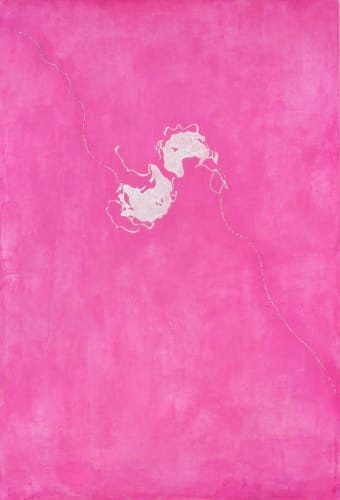New painting by Viktor Alimpiev always means new feelings. This is a change in worldview, and a different tonality, and even a different space, since the artist does not paint works without a reason, they are always “on the essence”. But the essence of the matter does not lie in the area of the plot, although the name of the series “My Mistresses” is associated with the theme of tenderness and possession.
When non-existence leaves, the Castle of Purity remains.
Stéphane Mallarmé. Igitur, or the Madness of Elbenon
The first thing that immediately marks a new beginning is a change in color. In this project, we are met by a rich and full-bodied alliance of pink and dark canvases, and the latter are also a duet of black and black-purple shades. Deep iridescent black, which has much in common with agate, a translucent black stone, has already been encountered in some of Alimpiev’s works, but black-purple, including pinkish fragments, now seems like an unexpected echo of the deep evening shadow from the landscape of the impressionists. Even more striking here is the pink of different shades, from warm-sunny to cold sunset. And this warm pink can be noted as a completely new color in Alimpiev's authorial palette.
Dark works are shaded by pink, like night next to dawn. This atmospheric comparison is logical, since painting is always a conversation about space, because no one has canceled the metaphor of a painting-window, even Rosalind Krauss, who proposed the concept of a lattice for the abstract painting of early modernism, since there was talk about a lattice on a window. In the painting of Viktor Alimpiev of different periods there were completely different representations of space (to go through which would be the topic of a special exciting study).
The shimmering and shimmering color of the paintings of the "My Mistresses" series clearly contains the light-air gene of classical painting, since it exists as an addition to the subject, is its background. Moreover, the background is both in Latin etymology, where fundus means "bottom", "foundation", and in Greek, where φωνή is a sound, and in this sense the color phonates, that is, makes its own sound, plays its own role, independent of "mistresses".
So we finally approached the very essence of the matter, to which this pictorial series-suite is dedicated, where the canvases, following one another, carry a changing, but similar motif of a light body, or even bodies touching, like a petal and a nose. It is amusing and unexpected that the artist decisively moves away from illusionism in the direction of specific plastic inventions - what is now designated by petals are strongly reduced fragments of drawings of women's heads, but they rest on a dense white, as if porcelain, base - as if a relief molded on the surface of the canvas. A careful drawing creates a rich physiognomic range of images: from beautiful lips folded like a bud to a laughing mouth (and sometimes a frightening grin), surrounded by a dozen facial lines of lovingly constructed cartographies of faces.
Thus, the image, having gone through a long chain of transformations: from the artist's hand to the computer monitor, again by hand onto tracing paper and then only onto the surface of a relief petal - acquires its own body, albeit white and thin, but resolutely separated from the pictorial background. The drawing, no matter whose contours it is inspired by, has another, independent embodiment, that is, a translation into new flesh, as if the features of a woman's face were repeated on the surface of the Moon - it is clear that this cosmic "bearer of features" will turn out to be much more powerful than its earthly prototype. Moreover, if you look closely at the images, gradually unraveling the intricate linear pattern, they always turn out to be doubled - a mirror repetition of themselves, sometimes in a slightly shifted perspective. That is, in addition to gifting the image with his own body, Alimpiev also doubles it, mirrors it - as if appropriating the prototype itself, depriving the latter of the right to be somewhere else, except for the picture.
"My Mistresses" turn out to be fragile, but independent constructions, their appearance and measured interweaving in pairs is somewhat remotely reminiscent of the principles of constructing an image in Marcel Duchamp's "Large Glass", which also creates a thin relief of colors against a disembodied, already completely transparent background. True, Duchamp attributed the multiplicity and circularity of movement to the masculine principle - the Mistresses there turn out to be Bachelors, whose conveyor belt is in a complex relationship with the image of the eternal immaculate Bride, either they are looking for her, or trying to escape. Duchamp's Bride is often considered an allegory of pure idea, brilliant higher reason and creativity - apparently, in the case of the art of Viktor Alimpiev, the idea and creativity are the artist's self-awareness (or the independent sound of the colored background of the paintings). In which mistresses, sculpted and painted by the artist, float on stems, shining like porcelain.

